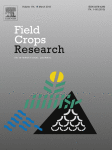Ver ítem
- xmlui.general.dspace_homeCentros Regionales y EEAsCentro Regional CórdobaEEA ManfrediArtículos científicosxmlui.ArtifactBrowser.ItemViewer.trail
- Inicio
- Centros Regionales y EEAs
- Centro Regional Córdoba
- EEA Manfredi
- Artículos científicos
- Ver ítem
Genetic improvement of peanut in Argentina between 1948 and 2004: light interception, biomass production and radiation use efficiency
Resumen
An important milestone in Argentina peanut (Arachis hypogaea L.) breeding was the shift in the 1970sfrom cultivars with erect growth habit (CEGH) to cultivars with procumbent growth habit (CPGH). CPGHimproved seed yield but also lengthened growth cycle. However, there is no information if the change ingrowth habit (GH) may have involved a phenotype with a canopy architecture that makes a differentialcapture and use of resources. Field experiments were
[ver mas...]
An important milestone in Argentina peanut (Arachis hypogaea L.) breeding was the shift in the 1970sfrom cultivars with erect growth habit (CEGH) to cultivars with procumbent growth habit (CPGH). CPGHimproved seed yield but also lengthened growth cycle. However, there is no information if the change ingrowth habit (GH) may have involved a phenotype with a canopy architecture that makes a differentialcapture and use of resources. Field experiments were performed to compute leaf are index (LAI), thefraction of incident photosynthetically active radiation intercepted by the crop (fIPAR), biomass produc-tion, radiation use efficiency (RUE) and harvest index (HI). Four cultivars of each GH, released between1948 and 2004, were evaluated. The LAI was always larger among CPGH than among CEGH. Only theformer reached the critical LAI. Likewise, fIPAR of CPGH was higher than that of CEGH throughout thecrop cycle. Maximum fIPAR differed between GHs (P < 0.001), with interannual mean values of 0.95 forCPGH and 0.77 for CEGH. Final total biomass of CPGH was 37% larger than that of CEGH. RUE valuesranged between 1.88 and 2.46 g MJ−1, and differed significantly (P ≤ 0.008) between GHs (CEGH > CPGH),Years (Year 1 > Year 2) and GH × Year (CPGH Year 1 > CPGH Year 2 = CEGH Year 2 = CEGH Year 1). CPGHimproved pod yield (+64%), seed yield (+101%), HI of pods (+29) and HI of seeds (+56%) respect to CEGH.Considering the effects of GH on the capacity of cultivars for achieving the critical LAI with current cropmanagement, future research should focus on alternative sowing patterns (e.g., reduced row spacingamong CEGH).
[Cerrar]

Autor
Haro Juarez, Ricardo Javier;
Baldessari, Jorge Javier;
Otegui, Maria Elena;
Fuente
Field crops research 204 : 222-228. (March 2017)
Fecha
2017-02-09
ISSN
0378-4290
Documentos Relacionados
Formato
pdf
Tipo de documento
artículo
Proyectos
(ver más)
INTA/PNIND/1108062/AR./Introduccion de variabilidad y mejora genética continua de los cultivos industriales.
Palabras Claves
Derechos de acceso
Restringido
 Excepto donde se diga explicitamente, este item se publica bajo la siguiente descripción: Creative Commons Attribution-NonCommercial-ShareAlike 2.5 Unported (CC BY-NC-SA 2.5)
Excepto donde se diga explicitamente, este item se publica bajo la siguiente descripción: Creative Commons Attribution-NonCommercial-ShareAlike 2.5 Unported (CC BY-NC-SA 2.5)

